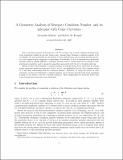| dc.contributor.author | Belloni, Alexandre | |
| dc.contributor.author | Freund, Robert Michael | |
| dc.date.accessioned | 2010-05-11T20:09:16Z | |
| dc.date.available | 2010-05-11T20:09:16Z | |
| dc.date.issued | 2008-01 | |
| dc.date.submitted | 2007-10 | |
| dc.identifier.issn | 1436-4646 | |
| dc.identifier.issn | 0025-5610 | |
| dc.identifier.uri | http://hdl.handle.net/1721.1/54761 | |
| dc.description.abstract | For a conic linear system of the form Ax ∈ K, K a convex cone, several
condition measures have been extensively studied in the last dozen years.Among these,
Renegar’s condition number C(A) is arguably the most prominent for its relation to
data perturbation, error bounds, problem geometry, and computational complexity of
algorithms.Nonetheless, C(A) is a representation-dependent measurewhich is usually
difficult to interpret and may lead to overly conservative bounds of computational
complexity and/or geometric quantities associated with the set of feasible solutions.
Herein we showthat Renegar’s condition number is bounded from above and belowby
certain purely geometric quantities associated with A and K; furthermore our bounds
highlight the role of the singular values of A and their relationship with the condition
number. Moreover, by using the notion of conic curvature, we show how Renegar’s
condition number can be used to provide both lower and upper bounds on the width of
the set of feasible solutions. This complements the literature where only lower bounds
have heretofore been developed. | en |
| dc.language.iso | en_US | |
| dc.publisher | Springer Berlin | en |
| dc.relation.isversionof | http://dx.doi.org/10.1007/s10107-007-0203-8 | en |
| dc.rights | Article is made available in accordance with the publisher's policy and may be subject to US copyright law. Please refer to the publisher's site for terms of use. | en |
| dc.source | Robert Freund | en |
| dc.title | A geometric analysis of Renegar's condition number, and its interplay with conic curvature | en |
| dc.type | Article | en |
| dc.identifier.citation | Belloni, Alexandre, and Robert Freund. “A geometric analysis of Renegar’s condition number, and its interplay with conic curvature.” Mathematical Programming 119.1 (2009): 95-107. ©2007 Springer-Verlag. | en |
| dc.contributor.department | Sloan School of Management | en_US |
| dc.contributor.approver | Freund, Robert Michael | |
| dc.contributor.mitauthor | Freund, Robert Michael | |
| dc.relation.journal | Mathematical Programming | en |
| dc.eprint.version | Author's final manuscript | |
| dc.type.uri | http://purl.org/eprint/type/SubmittedJournalArticle | en |
| eprint.status | http://purl.org/eprint/status/PeerReviewed | en |
| dspace.orderedauthors | Belloni, Alexandre; Freund, Robert M. | en |
| dc.identifier.orcid | https://orcid.org/0000-0002-1733-5363 | |
| mit.license | PUBLISHER_POLICY | en |
| mit.metadata.status | Complete | |
